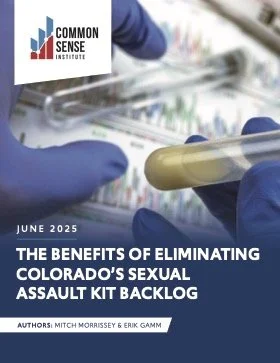By Erik Gamm and Mitch Morrissey
DNA evidence, where it’s available, is crucial to solving sexual assault cases—according to one study, it raises the likelihood of a guilty verdict from less than a third to nearly 75%. The trouble and expense of processing it, however, can create backlogs that put cases on hold for years. Dozens of state and local law-enforcement agencies have faced this problem over the decades since DNA technology emerged.
This year, due in part to years of alleged misconduct by one of its forensic scientists, the Colorado Bureau of Investigation (CBI) found itself with a queue of more than 1,400 untested sexual assault kits and without the means to process new ones promptly. The unsolved cases stuck in this backlog represent substantial further crime risks from repeat offenders, delayed justice for victims, and tangible costs to Colorado’s economy.
Key Findings
By processing all of the 1,369 DNA kits in the state’s backlog, Colorado could prosecute up to 200 rape cases.
This would also prevent up to 1,030 sexual assaults, 108 other violent crimes, 230 property offenses, and 113 drug/alcohol, public disorder, and other crimes.
At a testing cost of $2,000 per kit and adjudication, public-services, and work-loss costs totaling $82,000 per case, clearing the backlog and prosecuting cases associated with it will cost the state $21 million. In return, Colorado’s economy will eventually save $234.7 million due to prevention of future crimes.
The longer authorities take to clear the backlog, the larger the costs and smaller the savings will become.
CSI estimates that, by training 15 more DNA scientists over the next year, CBI will clear its DNA backlog of excess kits by July 2027. Delayed processing of kits currently in the backlog, which are expected to be tested by September 2026, will have allowed $51.8 million worth of additional criminal activity.
Even kits that don't lead to convictions are worth testing for the qualitative benefits they offer, like identifying deceased and incarcerated perpetrators, adding to the national DNA database, and providing closure to victims.
Greenwood Village, CO: Common Sense Institute, 2025. 12p.



